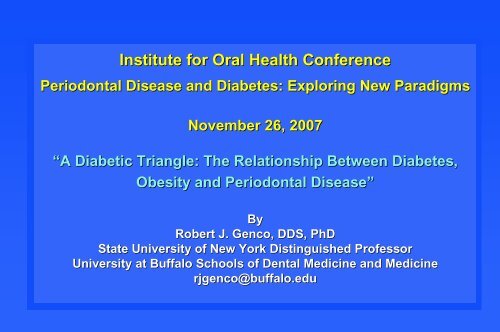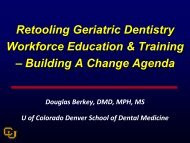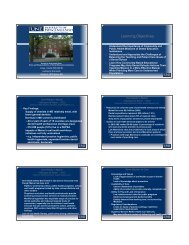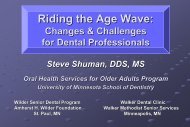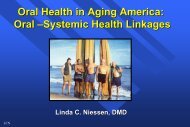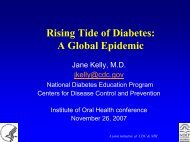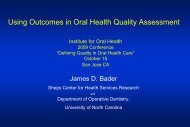PPT (2 MB) - Institute for Oral Health
PPT (2 MB) - Institute for Oral Health
PPT (2 MB) - Institute for Oral Health
You also want an ePaper? Increase the reach of your titles
YUMPU automatically turns print PDFs into web optimized ePapers that Google loves.
<strong>Institute</strong> <strong>for</strong> <strong>Oral</strong> <strong>Health</strong> Conference<br />
Periodontal Disease and Diabetes: Exploring New Paradigms<br />
November 26, 2007<br />
“A A Diabetic Triangle: The Relationship Between Diabetes,<br />
Obesity and Periodontal Disease”<br />
By<br />
Robert J. Genco, DDS, PhD<br />
State University of New York Distinguished Professor<br />
University at Buffalo Schools of Dental Medicine and Medicine<br />
rjgenco@buffalo.edu
A Diabetic Triangle<br />
I. Risk <strong>for</strong> Periodontal Disease<br />
II. Diabetes Mellitus<br />
A. Scope of the Problem<br />
B. Diabetes and Periodontal Disease
Risk Factor Studies<br />
Changing Concepts<br />
Periodontal diseases are caused by<br />
periodontal bacteria, the oral<br />
microbiome.<br />
Without these bacteria, there would<br />
be little or no periodontal<br />
destruction.
Why Study Risk Factors <strong>for</strong><br />
Destructive Periodontal Diseases<br />
• To determine factors important in<br />
increased susceptibility to<br />
periodontal disease<br />
• To provide the basis <strong>for</strong> risk factor<br />
intervention
THE ERIE COUNTY STUDY<br />
Study Design<br />
1. Adults 25 to 74 years of age<br />
2. Equal numbers of each decade<br />
(25 to 34; 35 to 44; etc.)<br />
3. Individuals of various socio-<br />
economic classes included<br />
Grossi et al. 1997
Periodontal Disease in Non-Insulin<br />
Dependent Diabetes Mellitus<br />
Objective:<br />
To determine if relationship between diabetes and<br />
destructive periodontal disease can be explained by oral<br />
health measures.<br />
Subjects: 1,342 dentate Pima Indians, cross-sectional<br />
sectional<br />
Periodontal Measurements: Clinical attachment loss, bone<br />
loss<br />
<strong>Oral</strong> <strong>Health</strong> Measurements: P.I., G.I., C.I., DMFT, F1<br />
Emrich et al., J. Periodontol. 62:123, 1991
Longitudinal Study of <strong>Oral</strong> <strong>Health</strong><br />
Status of Pima Indians<br />
Objective:<br />
Population:<br />
To determine the prevalence and the<br />
incidence of periodontal disease and<br />
its relationship to NIDDM.<br />
2,273 Pimas; 701 were examined at<br />
least twice.<br />
Nelson et al., Diabetes Care 13:836, 1990
Relative Risk<br />
Ratio of incidence rate of disease among those<br />
exposed over the incidence rate among those<br />
not exposed.<br />
RR = Incidence rate exposed<br />
Incidence rate unexposed<br />
RR = 75.7 (incidence rate of diabetes) = 1.95<br />
38.9 (incidence rate of normals)
Diabetes and Periodontal Disease:<br />
Levels of Evidence<br />
Diabetes Mellitus Type<br />
Study Type 1 2 1, 2 Unk<br />
Total<br />
Longitudinal Studies 3/3 4/4 0 0 7/7<br />
Cross-Sectional Studies 18/19 8/9 9/11 8/9 43/48<br />
Total 21/22 12/13 9/11 8/9 50/55
AIM<br />
To examine the relationship<br />
between obesity and<br />
periodontal disease in a<br />
representative national<br />
sample
POPULATION<br />
12,367 non-diabetic individuals<br />
from NHANES III study<br />
• 20 to 90 years old<br />
• No clinical diagnosis of DM<br />
• Fasting glucose
Smoking<br />
Stress<br />
Genetics<br />
Diet and<br />
Exercise<br />
Infection<br />
Obesity<br />
Markers/Mediators<br />
•CRP<br />
•II-6<br />
•TNF-α<br />
•Microalbuminuria<br />
Insulin<br />
Resistance<br />
Impaired<br />
Glucose<br />
Tolerance<br />
Type 2<br />
Diabetes<br />
Mellitus<br />
lipids<br />
adiponectin<br />
Cardiovascular Disease<br />
Renal Disease
Obesity and Insulin Resistance: Possible Role of Adipose<br />
Tissue Macrophages (ATM)<br />
Diet-Induced Obesity<br />
Shift in ATM from M-2 anti-inflammatory (Il-10)<br />
To M-1 proinflammatory<br />
TNFα, Il-6 that<br />
Block Insulin Action<br />
Insulin Resistance<br />
Lumeng, C.N. et al., J. Cl 117:175, 2007.
Population Affected by Risk Factors/Indicators<br />
Factor/Indicator<br />
% of<br />
Population Affected<br />
Cigarette smoking 26%<br />
Diabetes mellitus 6% (12%)<br />
Genetic factors<br />
varies<br />
Osteopenia/osteoporosis<br />
PM females (20%)<br />
Dietary calcium deficiency<br />
1/3 below 50% RDA<br />
Stress and inadequate coping 10%<br />
Obesity 20%<br />
Pre-existing existing periodontal disease<br />
5-35% (age dependent)
Four Important Considerations <strong>for</strong><br />
Clinical Use of Risk Factor Analysis<br />
1. Is there a convenient way to measure or<br />
otherwise assess the risk factor<br />
2. Is there a threshold level, above or below which,<br />
the risk factor provides clinically significant<br />
value<br />
3. What are the consequences of false positive<br />
and false negative results<br />
4. Does risk factor intervention or identification<br />
result in clinical benefit
Periodontal Disease Treatment TRIAD<br />
Antiinfective Therapy<br />
Risk Modification<br />
Regenerative Therapy
A Diabetic Triangle<br />
I. Risk <strong>for</strong> Periodontal Disease<br />
II. Diabetes Mellitus<br />
A. Scope of the Problem<br />
B. Diabetes and Periodontal Disease
Worldwide Incidence of Diabetes: 2000 and 2010<br />
14.2<br />
14.2<br />
17.5<br />
17.5<br />
23%<br />
23%<br />
26.5<br />
26.5<br />
32.9<br />
32.9<br />
24%<br />
24%<br />
84.6<br />
84.6<br />
132.3<br />
132.3<br />
57%<br />
57%<br />
15.6<br />
15.6<br />
22.5<br />
22.5<br />
44%<br />
44%<br />
9.4<br />
9.4<br />
14.1<br />
14.1<br />
50%<br />
50%<br />
World<br />
World<br />
2000:<br />
2000:<br />
151<br />
151<br />
million<br />
million<br />
2010:<br />
2010:<br />
221<br />
221<br />
million<br />
million<br />
Increase<br />
Increase<br />
46%<br />
46%<br />
1.0<br />
1.0<br />
1.3<br />
1.3<br />
33%<br />
33%<br />
Amos, A., McCarty, D. & Zimmet, P. The rising global burden of diabetes and its complications:<br />
estimates and projections to the year 2010. Diabetic Med. 14, S1-S85 (1997).<br />
Shoelson
Two Main Types of Diabetes<br />
Type 1 diabetes<br />
5-10% of total<br />
Common in children<br />
Insulin Requiring<br />
Auto-immune<br />
Destruction of the Islets<br />
Type 2 diabetes<br />
>90% of total<br />
Mostly in adults, but<br />
increasing in children<br />
Not insulin requiring<br />
Insulin resistant
Why is there an epidemic<br />
Shoelson
1990<br />
Diabetes prevalence<br />
is increasing rapidly<br />
1990-2000<br />
91-92<br />
92<br />
93-94<br />
94<br />
6%<br />
97-98<br />
98<br />
no data<br />
99-00
Prevalence of Obesity in U.S. Adults<br />
1990<br />
No data 20%<br />
Source: Mokdad, et al.<br />
Shoelson
Prevalence of Obesity in U.S. Adults<br />
2000<br />
No data 20%<br />
Source: Mokdad, et al.<br />
Shoelson
Insulin Resistance and<br />
β-Cell Function in<br />
Type 2 Diabetes
Insulin Resistance:<br />
Inherited and Acquired Influences<br />
Inherited<br />
Rare Mutations<br />
• Insulin receptor<br />
• Glucose transporter<br />
• Signaling proteins<br />
Common Forms<br />
• Largely unidentified<br />
Acquired<br />
• Inactivity<br />
• Overeating<br />
• Aging<br />
• Medications<br />
• Hyperglycemia<br />
• Elevated FFAs<br />
INSULIN RESISTANCE
Insulin Resistance:<br />
Causes and Associated Conditions<br />
Genetics<br />
Infections<br />
(Periodontal)<br />
Type 2<br />
Diabetes<br />
Obesity and<br />
inactivity<br />
Aging<br />
INSULIN<br />
RESISTANCE<br />
Medications<br />
Rare<br />
Disorders<br />
Hypertension<br />
Atherosclerosis<br />
Dyslipidemia
Possible Mechanisms of<br />
Hyperglycemia’s Adverse Effects<br />
• Sorbitol-myoinositol osmolarity changes (via aldose<br />
reductase pathway) – AR inhibitors have not been effective<br />
in clinical trials<br />
• Oxidative-redox stress – Not effective at usual doses<br />
• Non-enzymatic glycation reactions (AGE) – AGE blocker<br />
trials stopped due to side effects<br />
• • Activation of protein kinase C (PKC) – Diacylglycerol<br />
(DAG) pathway – PKCβ iso<strong>for</strong>m inhibitor trials are in<br />
progress
HbA 1c Predicts Coronary Heart Disease in<br />
Type 2 Diabetes<br />
25<br />
20<br />
15<br />
10<br />
5<br />
0<br />
CHD mortality<br />
Incidence (%) in 3.5 years<br />
Low<br />
7.9%<br />
25<br />
20<br />
15<br />
10<br />
5<br />
0<br />
All CHD events<br />
Incidence (%) in 3.5 years<br />
Low<br />
7.9%<br />
*P
Diabetes: A Systemic Disease<br />
Leading cause<br />
of blindness<br />
in working age<br />
adults 1<br />
Diabetic<br />
Retinopathy<br />
Periodontal<br />
disease increased<br />
in diabetes<br />
Periodontal<br />
Disease<br />
Stroke<br />
2- to 4-4<br />
fold<br />
increase in<br />
cardiovascular<br />
mortality<br />
and stroke 2<br />
Cardiovascular<br />
Disease<br />
Diabetic<br />
Nephropathy<br />
Leading cause of<br />
end-stage renal disease 3<br />
Diabetic<br />
Neuropathy<br />
Leading cause of non-traumatic<br />
lower extremity amputations 4<br />
National Diabetes In<strong>for</strong>mation Clearinghouse. Diabetes Statistics–Complications of Diabetes. (website)<br />
http://www.niddk.nih.gov/health/diabetes/pubs/dmstats/dmstats.htm#comp.
Diabetes<br />
Mellitus<br />
Periodontal<br />
Disease<br />
Effect of periodontitis on metabolic state.<br />
Effect of periodontal therapy on glycemic<br />
control.
Does Periodontal Disease Affect<br />
Glycemic Control<br />
Type 2 DM – Pima Indian study<br />
Baseline HbA1c < 9% (normal < 6-6.5%). 6 6.5%).<br />
Severe periodontitis at baseline (bone loss<br />
>50% or attachment loss > 6 mm on one or<br />
more teeth) significantly increased risk of<br />
poor glycemic control at 2 year follow-up.<br />
Taylor et al. 1996
Diabetes<br />
Mellitus<br />
Periodontal<br />
Disease<br />
Glycemic<br />
Control<br />
<br />
Periodontal<br />
Therapy
Can Periodontal Treatment<br />
Affect Glycemic Control<br />
• 125 Type 2 DM patients, severe<br />
periodontitis, , 5 groups<br />
• Periodontal status, HbA1c and pooled<br />
subgingival plaque sample at<br />
baseline, 3 months, 6 months<br />
Grossi et al. J Perio 1996, 1997
Change in Levels of glyHb After<br />
Periodontal Treatment
Effect of Periodontal Disease on<br />
Mortality in Type 2 Diabetes<br />
Saremi A. et al., Diabetes Care 28(1):27-32, 2005<br />
Study Design<br />
• 766 diabetic Pima Indians (287 men, 479 women)<br />
• Baseline PD measured<br />
• Followed 12 years (range 0.3-16.0)<br />
• 208 Natural deaths; cause validated
Results<br />
• Baseline Periodontal Disease<br />
44% males, 52% Females<br />
• Death Rate/1000 pyrs, , (age-sex<br />
adj)<br />
P.D. – 28.3 (22.2 – 34.4)<br />
Normal – 15.5 (10.7 – 20.2)
• Increased Death Rate <strong>for</strong> Periodontal<br />
Disease vs. Normal from:<br />
Cardiovascular disease – 2.7 (1.5 – 5.5)<br />
Diabetic nephropathy – 4.1 (1.5 – 11.4)<br />
Combined cardio-renal renal (adj(<br />
adj) – 2.3 (1.5-4.0)
Public <strong>Health</strong> Implications<br />
Resolution of periodontal infection appears to<br />
improve glycemic control in Type 2 diabetics.<br />
If it is shown that this also reduces diabetic<br />
complications, then management of periodontal<br />
infections becomes an important component of<br />
treatment of diabetes.<br />
“Medically necessary dental therapy”
PUBLIC HEALTH POLICY<br />
• Full RCT needed to determine if periodontal disease is a modifiable<br />
risk factor in patients with diabetes mellitus.<br />
• Meanwhile<br />
• Some insurers are covering periodontal care in patients with<br />
diabetes mellitus, and other conditions related to periodontal<br />
disease. Their economic data show a reduction in medical costs.<br />
• CDC in the U.S. is developing self-reported triage methodology to<br />
assist medical practices to identify patients who have periodontal<br />
disease.<br />
•<br />
Eke PI and Genco RJ. J. Periodontol. 78(Suppl):1366<br />
(Suppl):1366-1371, 1371, 2007.
ACKNOWLEDGMENTS<br />
• Marc Shlossman<br />
•Bill<br />
Knowler<br />
•George Taylor<br />
• Sara Grossi<br />
•Tom<br />
DeCaro<br />
•Todd Smith<br />
•Aramesh<br />
Saremi<br />
• Rob Nelson<br />
•Alex Ho<br />
•Bob<br />
Dun<strong>for</strong>d<br />
•George King<br />
•Funding: U.S. National <strong>Institute</strong> of Dental and Craniofacial Research, Sunstar Inc.,<br />
Colgate, Procter & Gamble, Atrix Laboratories, Inc., U.S. Centers <strong>for</strong> Disease Control
•Thank You!


